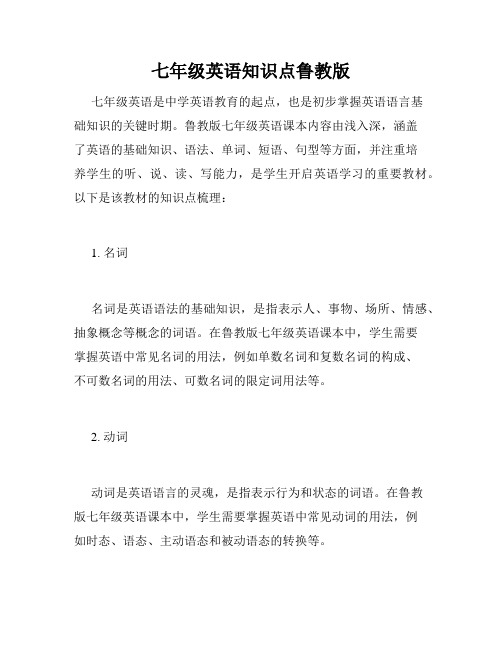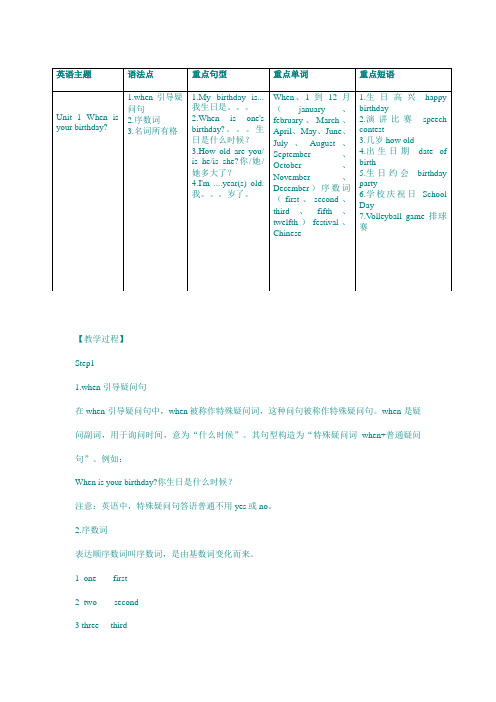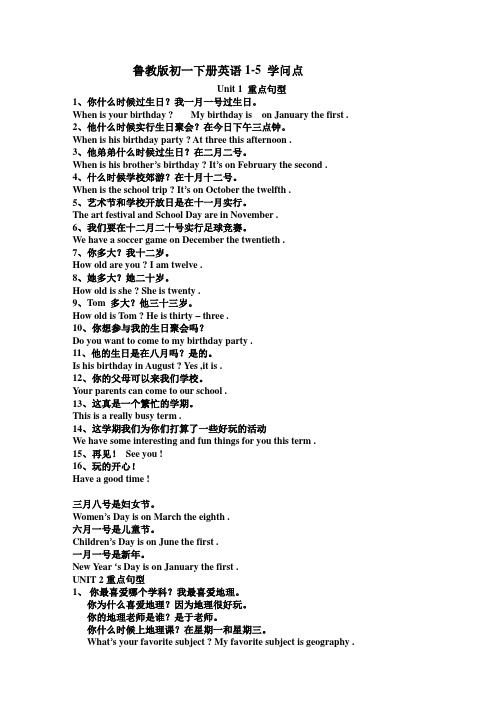七年级下学期-英语-知识点总结(鲁教版)(1)
鲁教版七年级英语下册主要知识点汇总

七年级下册主要知识点汇总第一单元短语归纳1.认为2.从...获得;向...学习3.查明;弄清4.谈话节目5.游戏节目6.肥皂剧7.go on8.watch a movie9.one of... 10.一双;一对11.尽某人最大努力try/do one's best 12 .look like 13.与...一样有名14.全世界15.就...讨论16.有一天17.例如18....的象征19.打扮;梳理20代替;替换21 干的好22令人愉快的事情23有趣的信息常考短语1查明;弄清 2.愿意迅速做某事 3.装扮;乔装打扮 4.代替;替代5干的好习惯用法汇总1.让某人做某事2.计划/打算做某事3.希望做某事4.碰巧做某事5.期待做某事6.做...怎么样?7.愿意迅速做某事;乐于做某事8.尽某人最大努力做某事9.你认为...怎么样?what do you thing of ...?=how do you like...? 10.让某人做某事let sb. do sth. 11.let's do sth.让我们做某事吧。
12.learn from sb./sth.向某人或某物学习13.learn sth.from sb./sth.向某人或某物学习某物14.某人发生了某事sth. happen s to sb. 15期待某人做某事expect sb.to do sth. 16.be serious about sth/doing sth..对做某事当真17,be famous for 因为。
而出名18 be famous as +职位或名称作为。
而闻名19 .be famous to sb。
为。
所熟知20对。
感兴趣be interested in第二单元短语归纳1.grow up------------2.every day --------------3.be sure about-------4.make sure --------------5.把...送到...---------------6.be able to +动词原形7.the meaning of...8.不同种类的9.in common 10.在...初11write down 12.have to do with 13.take up 14.hardly ever 15.太...以至于不能习惯用法归纳1.想要做某事2.打算做某事3.练习做某事4.不断地做某事5.学会做某事6.做完某事7.许诺去做某事8.帮助某人做某事9.记住做某事(事情还没做)10记得做过某事(事情已做过)11。
七年级下册鲁教版英语书u1知识点

七年级下册鲁教版英语书u1知识点鲁教版英语教材七年级下册第一单元主要讲解了名词、动词、形容词等基础语法知识,以及数字、日期、时间等实用词汇。
下面将针对每个知识点进行详细介绍。
名词(Noun)名词是指人、事、物、地点等具体或抽象的事物。
在英语中,名词分为可数名词(countable noun)和不可数名词(uncountable noun)。
可数名词可以用数目来表示数量,如book(s)、 dog(s);而不可数名词无法用数目表示数量,如water、money。
动词(Verb)动词是指表达具体或抽象动作、状态或发生一定行为的词汇,如run、swim。
除此之外,动词还能够用于构成时态、语态和被动语态等。
在英语中,动词的四种时态分别为一般现在时、一般过去时、一般将来时和现在进行时。
形容词(Adjective)形容词用来描述名词的性质、状态、种类和数量等特征。
英语形容词的基本用法是在名词前直接修饰,如small book、blue shirt。
数字(Number)数字是英语中最基本的词汇之一,它包括基数词(cardinal number)和序数词(ordinal number)。
基数词用来表示数量,如one、two;而序数词用来表示顺序或序列,如first、second。
日期(Date)日期是指一个具体的日子。
在英语中,日期的表达方式通常采用“月份+日期+年份”的方式,如July 4, 2021。
时间(Time)时间是指一天中分割时间段的一个单位。
英语中从早晨6点到中午12点用“am”表示,从中午12点到下午6点用“pm”表示。
时间的表达方式通常采用“小时+分钟”的方式,如9:30。
总之,学习这些基础语法知识和实用词汇对于英语学习者是非常重要的。
希望大家在学习的过程中能够不断积累,不断巩固,提高自己的英语水平,为今后更好地运用英语做好充分准备。
鲁教版七年级下英语各单元知识点归纳

鲁教版七年级下英语各单元知识点归纳Unit1 单元知识点归纳重点短语:1、think of 认为2、learn…from 向...学习3、find out 查明/弄清楚4、talk shows 访谈节目5、go on 发生/继续6、all over the world / throughout the world 在世界各地7、plan to do…/Make a plan to do …计划做...8、except to do 期待着做某事9、try one’s best to do…/ do one’s best to do…尽某人最大的努力10、for example / such as 例如11、dress up 打扮/梳理12、instead of 代替/替换13、something pleasant 令人愉快的东西14、willing and quick to do sth 愿意迅速做某事15、well done 干得好16、hope to do / wish to do 希望做某事17、talent show 才艺展示18、action movies 动作片19、want to do something 想做……20、hope to do something 希望做……21、expect to do something 期待做……22、plan to do something 计划做……23、join sb (in something)参加某人的……24、sports show 体育节目25、talent show 才艺展26、game show 游戏节目27、soap opera 肥皂剧28、scary movies 恐怖电影29、come out 出版,发行,(花)开,(太阳等)出来30、be ready to do something 准备做……重点句型:1、Some people might ask how this cartoon animal became so popular.有些人可能会问这个卡通动物怎样变得如此受欢迎了呢。
七年级英语知识点鲁教版

七年级英语知识点鲁教版七年级英语是中学英语教育的起点,也是初步掌握英语语言基础知识的关键时期。
鲁教版七年级英语课本内容由浅入深,涵盖了英语的基础知识、语法、单词、短语、句型等方面,并注重培养学生的听、说、读、写能力,是学生开启英语学习的重要教材。
以下是该教材的知识点梳理:1. 名词名词是英语语法的基础知识,是指表示人、事物、场所、情感、抽象概念等概念的词语。
在鲁教版七年级英语课本中,学生需要掌握英语中常见名词的用法,例如单数名词和复数名词的构成、不可数名词的用法、可数名词的限定词用法等。
2. 动词动词是英语语言的灵魂,是指表示行为和状态的词语。
在鲁教版七年级英语课本中,学生需要掌握英语中常见动词的用法,例如时态、语态、主动语态和被动语态的转换等。
3. 形容词形容词是用来描述人、事物、场所、情感等概念的词语。
在鲁教版七年级英语课本中,学生需要掌握形容词的基本用法,例如形容词的比较级和最高级、形容词修饰名词的位置、形容词和副词的区别等。
4. 副词副词是用来描述动词、形容词、其他副词和整个句子的词语。
在鲁教版七年级英语课本中,学生需要掌握副词的基本用法,例如副词修饰动词和形容词的位置、副词的比较级和最高级等。
5. 介词介词是用来表示方位、时间、原因、目的等概念的词语。
在鲁教版七年级英语课本中,学生需要掌握介词的基本用法,例如介词的用法和搭配、介词短语的位置等。
6. 冠词冠词是英语中特有的一种限定词,包括定冠词和不定冠词。
在鲁教版七年级英语课本中,学生需要掌握冠词的基本用法,例如定冠词和不定冠词的用法、冠词修饰名词的位置等。
7. 代词代词是用来代替名词和其他代词的词语,以避免重复使用。
在鲁教版七年级英语课本中,学生需要掌握代词的基本用法,例如人称代词、物主代词、反身代词和指示代词的特点和用法等。
8. 数词数词是用来表示数量的词语,包括基数词、序数词、分数和百分数等。
在鲁教版七年级英语课本中,学生需要掌握数词的基本用法,例如基数词和序数词的用法、分数和百分数的用法和表示方法等。
鲁教版(五四学制)七年级下册英语Unit 1 语法知识清单

鲁教版(五四学制)七年级下册英语Unit 1 语法知识清单Unit 1 Do you want to watch a game show? 知识清单词形转换Section Acation(n. )教育adj. educational 教育的;有教育意义的2.plan(u.&n.)打算;计划过去式planned 现在分词planning3.discussion(n. )讨论;商量n.discuss 讨论4.stand(v.)忍受;站立过去式stoodedy(n. )喜剧;喜剧片pl. ComediesSection B1.mean(v.)意思是_ n. meaning 意义;意思adj, meaningful 意味深长的,意义明显的反义词meaningless 毫无意义的;意思不明确的2. act(v.)行为;扮演_ n. action行动3. appear(v.)出现反义词disappear消失4. become(v.)开始变得;变成过去式became5. rich(adj.)富有的_反义词poor贫穷的6. success(n.)成功adj. successful获得成功的_ adu.successfully成功地7. film(n. )电影_ 同义词movie8. lucky(adj. )幸运的反义词unlucky不幸的;不吉利的adv. luckily 幸运地9. lose(v. )失去;丢失过去式lost10. simple(adj. )简单的;易做的同义词easy adv. simply 简单地11. army(n.)陆军;陆军部队pl. Armies12.famous 著名的,出名的;同义词well-known重要短语和知识点:Section A1.talk show访谈节目2.soap opera肥皂剧3.sports show体育节目4.game show游戏节目5.talent show才艺节目6.soccer game足球比赛7.don't mind不介意;无所谓mind (one’s) doing介意某人做某事Do you mind my/me calling you at night?8. can't stand (doing) sth. 不能忍受Jack can’t stand staying at home.9. think of认为10. watch the news看新闻11. find out查明;弄清look for “寻找”,强调找的动作和过程What are you looking for?find “找到,发现”,强调找的结果He found the cat at last.Can you find out what time the meeting starts?12.around the world全世界13. have a discussion about.. 进行一场关于....的讨论14. my favorite TV shows我最喜欢的电视节目15. expect (sb.) to do sth.期待(某人)做某事16. learn a lot from...从...中学到很多17. one day (有)一天18. hope to do sth. 希望做某事(主语希望自己)I hope to see you again.hope + that 从句I hope that he will come soon.19.plan to do sth.打算做某事;计划做某事make a plan for...为......制定计划We must make a plan for our holiday.20.want to do sth.想要做某事21. watch a sports show观看体育节目Section B1.action movie动作影片2.scary movie恐怖片。
2021年鲁教版初一英语下知识点总结

【教学过程】Step11.when 引导疑问句在when 引导疑问句中,when被称作特殊疑问词,这种问句被称作特殊疑问句。
when 是疑问副词,用于询问时间,意为“什么时候”。
其句型构造为“特殊疑问词when+普通疑问句”。
例如:When is your birthday?你生日是什么时候?注意:英语中,特殊疑问句答语普通不用yes或no。
2.序数词表达顺序数词叫序数词,是由基数词变化而来。
1 one -----first2 two------second3 three----third别的序数词是由基数词后加-th 变化而来。
几种特殊变化序数词1 five----fifth2 twelve----twelfth3 eight----eighth4 nine----ninth整十序数词把 y 变成 i加-e th1 twenty----twentieth2 thirty----thirtieth3 forty----fortieth4 fifty -----fiftieth几十几序数词,十位数不变,个位数变成序数词。
1. twenty-one 21----twenty-first 21st2.thirty-two 32-----thirty-second 32nd3.ninety-nine 99----ninety-ninth 99thStep21.名词所有格英语名词所有格有两种:'s属格和of属格。
1.名词所有格表达名词所关于系,有两种形式。
A.由名词后加's或' 构成,多用来表达有生命人或动物。
B.由介系词of加名词构成,多用来表达无生命人或动物。
(1)'s所有格用法:a)重要用于有生命名词,例如:my brother's books,Mary's boyfriend,shee p's skin.b)用于地理、国家机关、都市等名词,例如:Beijing's future,the government's dec ision.c)用于时间、价值、距离、重量等名词,例如:today's assignment,ten dollars' wort h,fivemiles' distance,twenty pounds' weight.d)表达理发店、商店等名词或某些习惯用法,例如:at the butcher's,at one's wit's end.(2)of所有格用法:重要用于表达无生命名词,例如:the door of the house,a ma p of China.(3)双重属格用法:重要用来表达人所关于系,例如:a friend of my brother's,two plays of Shakespeare's,some children of Mr. Brown's,these ideas of yours,th ose dirty shoes of James'.双重属格名词前不能用the和one来修饰。
鲁教版初一下册英语知识点

鲁教版初一下册英语1-5 学问点Unit 1 重点句型1、你什么时候过生日?我一月一号过生日。
When is your birthday ? My birthday is on January the first .2、他什么时候实行生日聚会?在今日下午三点钟。
When is his birthday party ? At three this afternoon .3、他弟弟什么时候过生日?在二月二号。
When is his brother’s birthday ? It’s on February the second .4、什么时候学校郊游?在十月十二号。
When is the school trip ? It’s on October the twelfth .5、艺术节和学校开放日是在十一月实行。
The art festival and School Day are in November .6、我们要在十二月二十号实行足球竞赛。
We have a soccer game on December the twentieth .7、你多大?我十二岁。
How old are you ? I am twelve .8、她多大?她二十岁。
How old is she ? She is twenty .9、Tom 多大?他三十三岁。
How old is Tom ? He is thirty – three .10、你想参与我的生日聚会吗?Do you want to come to my birthday party .11、他的生日是在八月吗?是的。
Is his birthday in August ? Yes ,it is .12、你的父母可以来我们学校。
Your parents can come to our school .13、这真是一个繁忙的学期。
This is a really busy term .14、这学期我们为你们打算了一些好玩的活动We have some interesting and fun things for you this term .15、再见!See you !16、玩的开心!Have a good time !三月八号是妇女节。
鲁教版七年级英语下册主要知识点汇总

七年级下册主要知识点汇总第一单元短语归纳1、认为2、从、、、获得;向、、、学习3、查明;弄清4、谈话节目5、游戏节目6、肥皂剧7、go on8、watch a movie9、one of、、、10、一双;一对11、尽某人最大努力try/do one's best 12 、look like 13、与、、、一样有名14、全世界15、就、、、讨论16、有一天17、例如18、、、、的象征19、打扮;梳理20代替;替换21 干的好22令人愉快的事情23有趣的信息常考短语1查明;弄清2、愿意迅速做某事3、装扮;乔装打扮4、代替;替代5干的好习惯用法汇总1、让某人做某事2、计划/打算做某事3、希望做某事4、碰巧做某事5、期待做某事6、做、、、怎么样?7、愿意迅速做某事;乐于做某事8、尽某人最大努力做某事9、您认为、、、怎么样?what do you thing of 、、、?=how do you like、、、? 10、让某人做某事let sb、do sth、11、let's do sth、让我们做某事吧。
12、learn from sb、/sth、向某人或某物学习13、learn sth、from sb、/sth、向某人或某物学习某物14、某人发生了某事sth、happen s to sb、15期待某人做某事expect sb、to do sth、16、be serious about sth/doing sth、、对做某事当真17,be famous for 因为。
而出名18 be famous as +职位或名称作为。
而闻名19 、be famous to sb。
为。
所熟知20对。
感兴趣be interested in第二单元短语归纳1、grow up------------2、every day --------------3、be sure about-------4、make sure --------------5、把、、、送到、、、---------------6、be able to +动词原形7、the meaning of、、、8、不同种类的9、in common 10、在、、、初11write down 12、have to do with 13、take up 14、hardly ever 15、太、、、以至于不能习惯用法归纳1、想要做某事2、打算做某事3、练习做某事4、不断地做某事5、学会做某事6、做完某事7、许诺去做某事8、帮助某人做某事9、记住做某事(事情还没做) 10记得做过某事(事情已做过) 11。
- 1、下载文档前请自行甄别文档内容的完整性,平台不提供额外的编辑、内容补充、找答案等附加服务。
- 2、"仅部分预览"的文档,不可在线预览部分如存在完整性等问题,可反馈申请退款(可完整预览的文档不适用该条件!)。
- 3、如文档侵犯您的权益,请联系客服反馈,我们会尽快为您处理(人工客服工作时间:9:00-18:30)。
七年级下册常考知识点汇总find out 2.be ready to 3.dress up 4.take one's place 5.do a good job 6.try/do one's best 7.learn from 8.a pair of 9.let sb. do sth.10.plan to do sth. 11.hope to do sth. 12..happen to do sth.13.expect to do sth.14.how about doing ?15.be ready to do sth.愿意迅速做某事;准备做某事16.try /do one's best to do sth.17.be interested in sth./doing sth.18.what do you think of.....?=how do you like of ...?你认为。
怎么样?19.have a discussion about20.something enjoyable令人愉快的动东西,(形容词作不定代词的后置短语)21.stop to do sth.停下来去做某事22.stop doing sth.停止做某事23.forget to do sth.忘记做某事(事情还没有做)24.forget doing sth.忘记做过某事(事情做了)25.remember to do sth. 记住做某事(事情没做)26.remember doing sth.记住做过某事(事情做了)27.try to do sth. 设法做某事28.try doing sth.尝试做某事28.grow up 29.make sure 30.be sure about /of +名词/动名词,对...有把握;确信31.write down(动+副)写下;记下32.in common 33.have to do with 34.take up 35.hardly ever 35.too+形容词/副词+to+动词原形,太...以至于不能。
36.agree with sb.37.send ...to...38.be able to+动词原形=can+动词原形能。
39.different kinds of+名词复数,各种各样的40.at the beginning of ...41.want to do sth. 42.be going to +动词原形打算做某事43.practice doing sth.44.keep on doing sth.不断地做某事,(动作的反复);keep doing sth.(表示动作或状态的持续)45.learn to do sth. 46.finish doing sth.47.promise to do sth.48.help sb.(to) do sth.49.agree to do sth. 50 love to do sth.51 send sb.sth.=send sth. to sb.把某物送/寄给某人52.send for 派人去请第三单元. 1.will+动词原形将要做...2.fewer/more+可数名词复数更少/更多...3.less /more+不可数名词更少/更多...4.try to do sth.尽力做某事 5.不得不做某事 6.have to do sth.6.agree with sb.同意某人的意见7.参与某事play a pary in doing sth. 8.让某人做某事make sb. do sth.9.help sb.with sth.帮助某人做某事10.将会有。
there will be +主语+其他11.有...正在做某事there is/are +sb./sth._+doing sth. 12.it is +形容词+for sb.+to do sth.做某事对某人来说是...13.spend+时间/金钱+on sth. 在...上花费时间或金钱14.spend+时间或金钱+ ( in) doing sth.花费时间或金钱做某事常考短语.1参与play a part 2.多次;反复地over and over again 3.许多;大量hundreds of 4.醒来wake up 5.突然倒下;跌倒fall down 6.寻求;寻找look for 7.能够做某事be able to do sth.8.似乎/看来/好像做某事seem to do sth.第四单元常考短语1. .接通(电流、煤气。
水等);打开2.切碎3. 一片/张/段/首...4. 用...把...装满5. 一些;几个6. 用...覆盖...7.充满...be full of...=be filled with...句型与搭配1. 1.多少 ... how many+可数名词复数2.多少... how much +不可数名词3 .让某人做某事 let sb.do sth. 4.想要做某事 want to do sth. 5.忘记去做某事 forgetto dosth. 忘记做过某事forget doing sht.6.如何做某事 how to do sth. 7...一前 一段时间+ago 8.通过做某事 by doing sth. 9.需要做某事 need to do sth. 10.使...怎样 make +宾语+形容词 使。
怎样”,形容词作宾语补足语。
11.到(某人)做某事的时间了 it 's time (for sb.)to do sth. 12 turn on the blender 打开食物搅拌器(教材第25页)解析:这是一个祈使句。
祈使句用来表示请求、命令、劝告、建议等。
祈使句的主语一般都是第二人称you ,但往往省略。
祈使句的谓语用动词原形。
否定祈使句通常一don't 开头。
Don't forget to turn off the light 。
辨析:turn on 与open打开门,并打开所有的灯。
注意:turn on 是动词+副词型短语,宾语是代词时,要放在turn 和on 中间。
拓展:turn up 调(音量等) turn down 调低(音量等13. cut up 意为“切碎”,是“动词+副词”型短语,宾语是代词,只能放在cut 和up中间。
14. Pour ...into...“把。
倒进。
”into 为介词,意为“到。
里;进到。
内”。
15. .How do you make a banana milk shake?你怎样做香蕉奶昔?(教材第25页)解析:这是一个特殊疑问句,疑问词how 意为“怎样,如何”,用来对做某事的方法、方式、途径及动作程度等进行提问。
16.How many bananas do we need? 我们需要多少香蕉?(教材第26页)how many 意为“多少”,用来提问可数名词的数量。
How many birds are there in the tree ?妙辨异同:how many 与how much来表示数量,修饰不可数名词或可数名词复数。
a cup of tea three bags of salt fvie bottles of flowers then bottles of water18. Can you tell me how?你能告诉我怎么做吗?(教材第26页)解析:can 情态动词,意为“能”,在此表示请求。
有时也用could,语气比can更委婉,在回答“Can/Could you ...?”句型时,肯定回答常用“sure.”“Of course.”等,否定回答常用“Sorry ,I can'19. put...into...意为“把...放进...”。
20.Then add the cabbage ,tomatoes and onion and cook for another 10 minutes.然后加入卷心菜、西红柿和洋葱再煮10分钟。
(教材第26页)解析:1)tomato名词“西红柿”。
注意:以字母o结尾的名词变复数时,有的加-s,有的加-es。
但potato(土豆),tomato(西红柿),hero(英雄),mango(芒果)4个单词必须加es构成复数。
这4个单词用一句话穿起来:英雄(hero)爱吃土豆(potato)、西红柿(tomato)和芒果(mango)2)another 10 minutes意为“另外10分钟”。
another+基数词+名词表示“又/再/另。
”21. :more 也可以表示“又,再”,但与基数词连用时,它与another 位置不同:another 在基数词前;more在基数词后。
We stayed there for two more days我们在那儿又呆了两天。
注意:基数词+more+名词相当于another+基数词+名词。
22. .Do you know how to plant a tree?你知道如何种树吗?(教材第27页)How to plant tree是“疑问词+动词不定式”结构,在句中作谓语动词know的宾语。
“疑问词+动词不定式”结构,可在句中作主语、宾语、表语等成分23. by+v-ing 形式,意为“通过做某事”。
介词by意为“通过。
,凭。
,以。
”,后面需接v-ing形式,表示通过做某事而得到某种结果。
常用回答how do you ....?或How can I ...?这类问句。
--How do you learn English?你怎样学英语?--I learn English by listening to English songs.我通过听英文歌曲学习英语。
24. :fill...with...把。
用。
装满(表示动作)表主动The boy filled the bottle with sand.那个男孩用沙子把瓶子装满了。
be filled with...装满。
(表示状态),表被动。
是固定短语My life is filled with happiness.我的生活充满快乐。
拓展:full形容词“满的”,be full of表示“充满。
”,相当于be filled withThe bottle was full of milk.=The bottle was filled with milk.瓶子里装满了牛奶。
25. 辨析:a few ,few ,a little 与little常考短语1.为...做准备2.其他时间;别的时间3.常去某处;泡在某处4.前天5.后天6.照料;照顾7.去旅行8.盼望;期待用法归纳1.邀请某人做某事2.what引导的感叹句的结构:what+a/an +形容词+单数可数名词(+主语+谓语)!What+形容词+复数可数名词/不可数名词(+主语+谓语)!2.帮助某人做某事 4.做某事很难过 5.看见某人做某事,看见某人正在做某事 6.做某事的最好方式7.为某人举行的一个惊喜派对8.期待做某事9.答复某人/某事10.今天是什么日子?今天是几月几日?今天是星期几? 准备做某事11.prepare to do sth.12拒绝做某事refuse to do sth. 13.be surprised to do sth 对做某事感到意外14。
